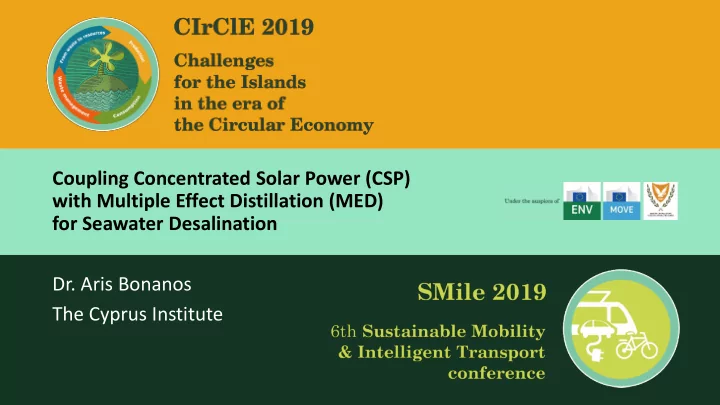

Coupling Concentrated Solar Power (CSP) with Multiple Effect Distillation (MED) for Seawater Desalination Dr. Aris Bonanos The Cyprus Institute
• Global Water Stress • Water Stress Index: • Total water use vs. water availability • > 3 billion people experience water scarcity • Precipitation predictions • Reduction in both winter and summer precipitation Water Stress by country: 2040 rates in near future • Desalination • 97.6% of Earth’s water is in oceans/saltwater • A potential solution for water scarcity! Scenario RCP2.6 Scenario RCP8.5 World Resources Institute. Aqueduct, Water Stress by 2040 IPCC , Climate Change 2014, Synthesis Report, 2014
• Desalination T sw = 25 ° C, X dist = 0 ppm • Very energy intensive process • Energy form impacts energy consumed by process • Energy depends on source salinity & recovery ratio • RO → electrical energy → 3-3.5 kWh/m 3 Work driven process • MED → thermal energy → 20-30 kWh/m 3 • Theoretical energy of separation • Much less than energy of actual process • Room for improvement! • In Cyprus: • >1 % of GDP and 4% of energy goes towards desalination Heat driven process K.H. Mistry, Irreversibilities and Nonidealities in Desalination Systems, 2013
The CSP-DSW co-generation scheme will try to utilise the all available thermal energy from the various subsystems Water Stress The advantages of CSP-DSW are realized only when the power and desalination Solar Resource Potential cycles are integrated thermally and optimized together.
• Heliostat field layout: • Deployment on hilly terrain • 50 heliostats • 5 rows • 3 focal lengths • 25, 33 and 45 m • Field angle of 75-deg f = 45 m f = 33 m f = 25 m 75 ° 6.0 18.0 z y
• Multiple Effect Distillation (MED) • Utilization of waste heat from plant • Energy recycling to decrease specific energy requirements Steam in Seawater in Vapor product Condensate out Brine
• Experimental characterization of a 4-effect unit • Performance ratio (PR) • PR = <mass of distillate> / <mass of seawater> • Study influence of parameters on PR • Seawater temperature • Steam temperature • # of effects • Development of model • Focus on predicting dynamic behavior of unit • Flexibility in terms of • Feed water configuration • Feed-heater utilization • Heat transfer coefficient # of effects
• Coupling MED with the CSP plant
• Heat flow in a CSP-Plant • Identification of sources to drive MED Convective loss from cavity Turbine outlet • Use other waste heat sources of receiver • Q st ~ 9.5 kW • Q r,conv ~ 12-20 kW • T = 82 ° C the plant: • T = 200 ° C • Steam as fluid • Air as fluid • Thermal vapor compression to improve PR • Requires higher temperature source • Energy for zero-liquid discharge setup • Reduce environmental impact Cooling of receiver secondary concentrator Ranking cycle condenser • Q r,sec ~ 5 kW • Q cond ~ 11 kW • T = 80 ° C • T = 45 ° C • Air/water as fluid • Seawater as fluid A. Bonanos, AIP Proceedings, 2017 R. Pitz-Paal, Concentrating Solar Power Systems, DOI: 10.1051/epjconf/20174800008, 2017
Thank nk you f u for r your ur at attentio tention Dr. Aris Bonanos bonanos@cyi.ac.cy (+357) 22208665
Recommend
More recommend